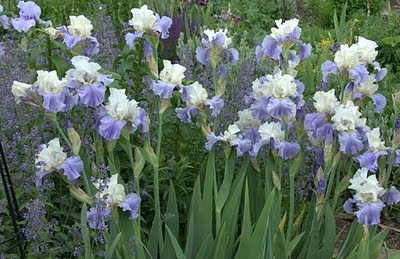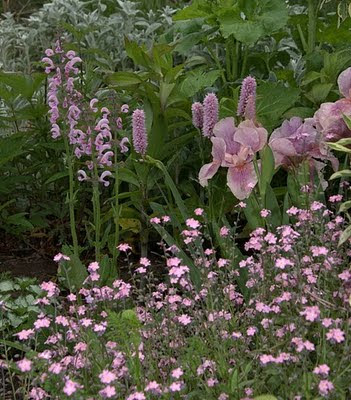I expected to grow weary of this obsession within a few months and to move on, perhaps to something more respectable like playing Resident Evil 5. I was mistaken, and my nightly sojourns only leave me wanting more. Occasionally I find a photograph that is so beautiful that I must share. My husband Mike is a good sport, and will give an animated nod of appreciation when I call him in to look at an especially pretty iris, but to tell the truth, from the glazed appearance of his eyes, I suspect the Nairobi Trio is playing in his head.
When I saw Barbara Kuhlman's photograph of Ben Hager's iris 'Edith Wolford' on Gardenweb, I knew I couldn't limit my sharing to Mikey. I had to share it with all of you.
After a night spent with this photo, I recalled another lovely picture of 'Edith Wolford' and decided on the theme 'heavenly Hager irises.' I was smitten with this enchanting photo by Laurawege on Dave's Garden quite some time ago. Here the geraniums and delphiniums make perfect companions, and have me fantasizing about a new lavendar-blue and yellow bed in my garden.
All of Joel Shaber's photographs of his Idaho garden are worth staying up into the wee hours to view, but his images of 'Edith Wolford' are particularly lovely. These photos show why this iris won the highest honor for an iris, the Dykes Medal, in 1993.
The word 'clump' seems unsuited to describe such beauty.
'Edith Wolford' blooms midseason and is a tall iris, reaching 40 inches.
Susanne Holland Spicker grows irises in her brilliantly coordinated and charming Utah garden. She feeds the iris addiction with her exceptional photography in her blog, Sowing the Seeds, a great site for late-night iris ogling. Here she has captured the beauty of Hager's 'Poem of Ecstacy' which she grows with 'Jump For Joy.'
'Poem of Ecstacy' was the winner of the John C. Wister Memorial Medal for tall bearded irises in 2004. Here it is paired with tall lupines in Susanne's garden, demonstrating her talent combining plants with different forms and coordinating colors.
'Poem of Ecstacy' grows to be about 36" tall and blooms midseason.
'Beverly Sills' is Ben Hager's most famous iris, with consistently high ratings in the American Iris Society's popularity polls. It was the 1985 winner of the Dykes Medal, and is named after the famous opera singer. It does her justice.
This iris is easy to grow in Southern California and makes a satisfying clump in a short period of time. It has quite an extended bloom season in cool weather here. Last year it was blooming from late April through June.

'Beverly Sills' is a pale, warm pink. It is a photogenic iris, and has the wide falls that Ben Hager is so famous for creating.
This is 'Beverly Sills' with 'Lady Friend.'
'Chasing Rainbows' is a 1998 Hager introduction. Naomi DiVincenzo, an avid gardener who has just won her first blue ribbon for iris horticulture, grows a lovely clump on her grounds, Front Range Iris, in Colorado. You can see how she brought home the blue from this photo.
One of my regular stops during my nighttime forays on the internet is the archive of the American Iris Society's annual Photo Contest. This is why:
This photo of 'Chasing Rainbows' by Becky Fain, the proprietor of the Inn at Iris Meadows in North Carolina, won first prize and appeared on the cover of the AIS magazine. I wanted to make sure that those of you new to growing irises got to see it too.
The American Iris Society Photography Contest is a wonderful way to share your irises, your garden, and your photography with other iris lovers. The deadline this year is June 30, so if you love taking pictures of your irises, please consider entering. We have many long nights ahead in front of the computer, and we need more beautiful photos!








.jpg)





